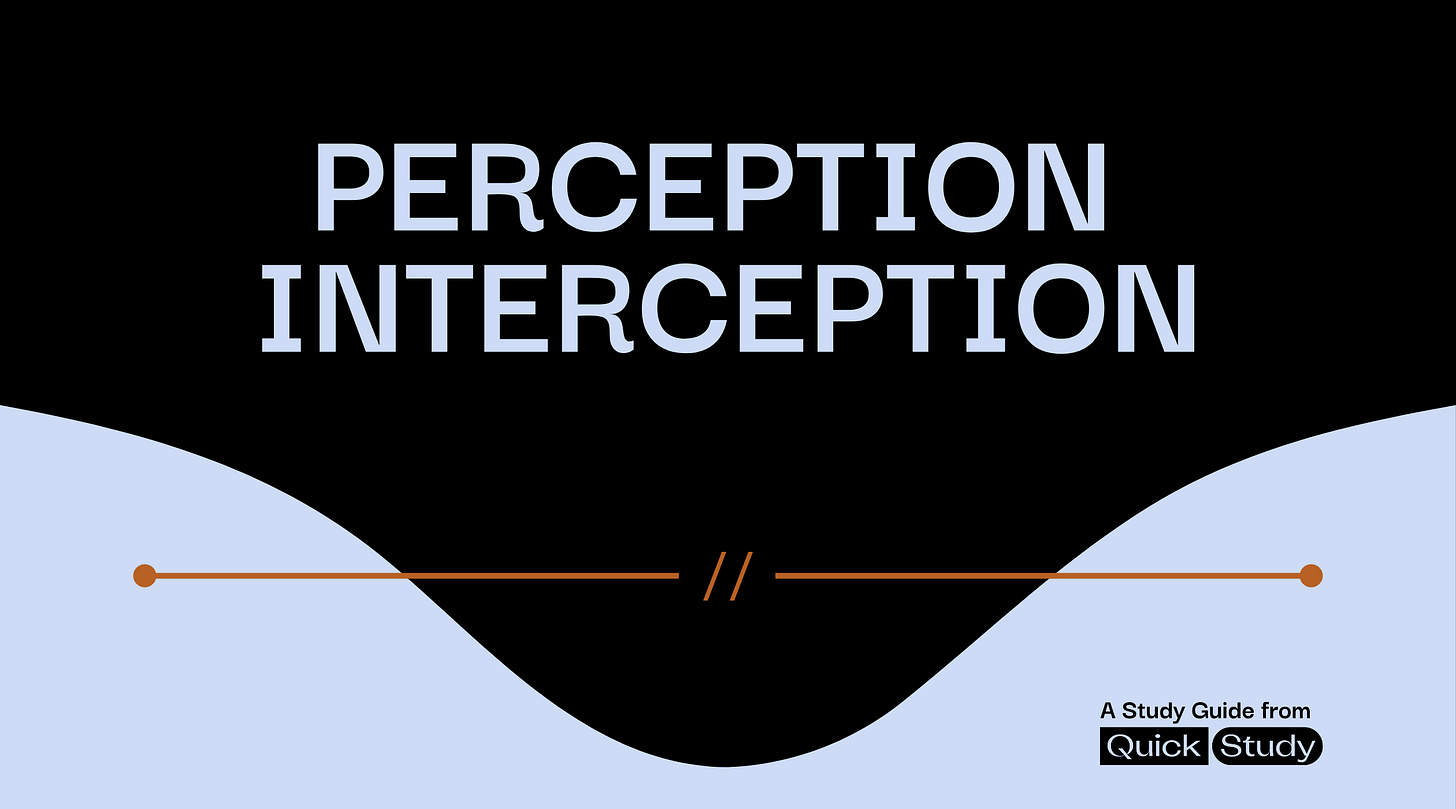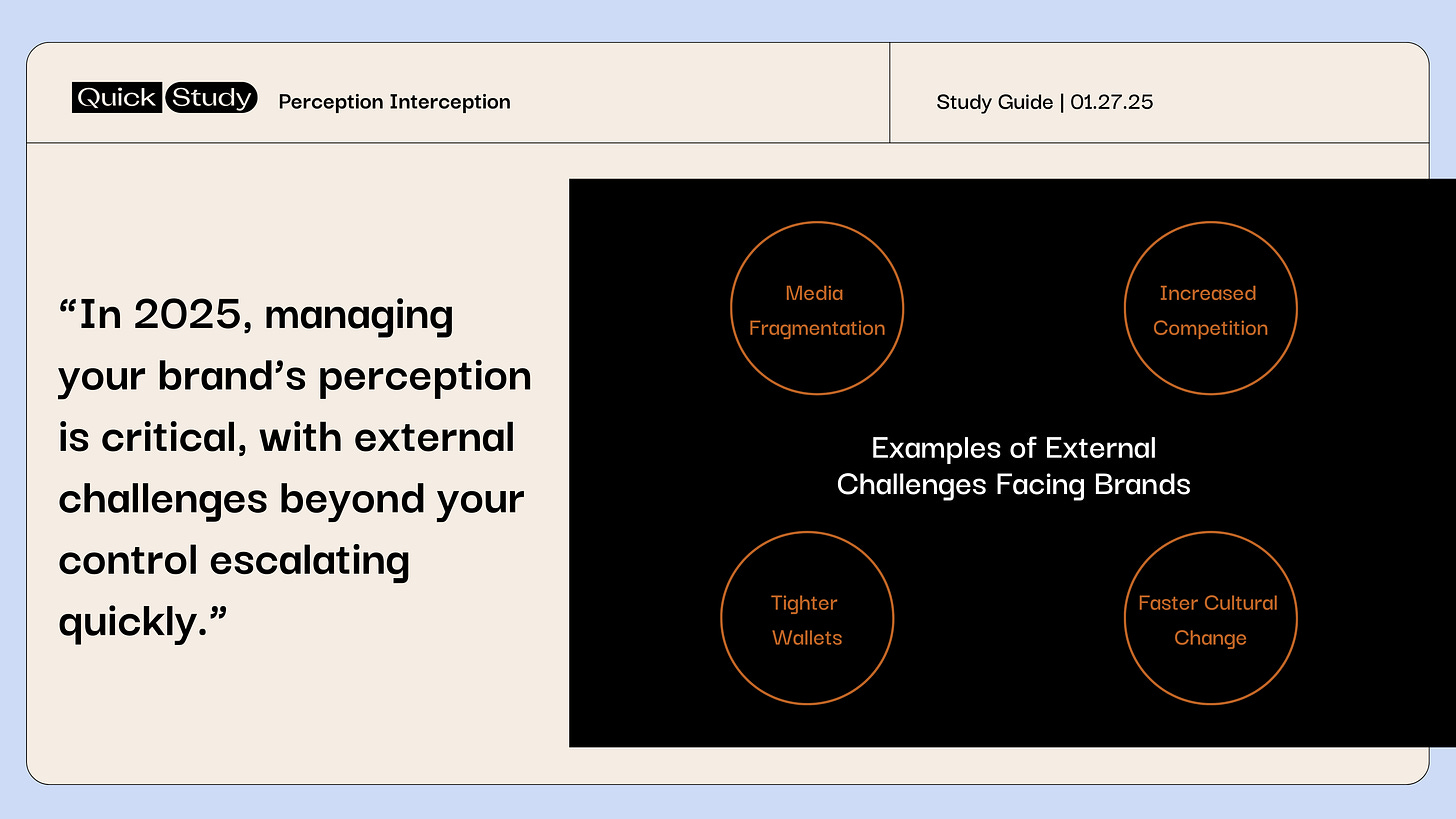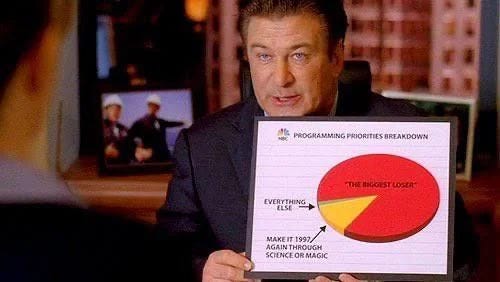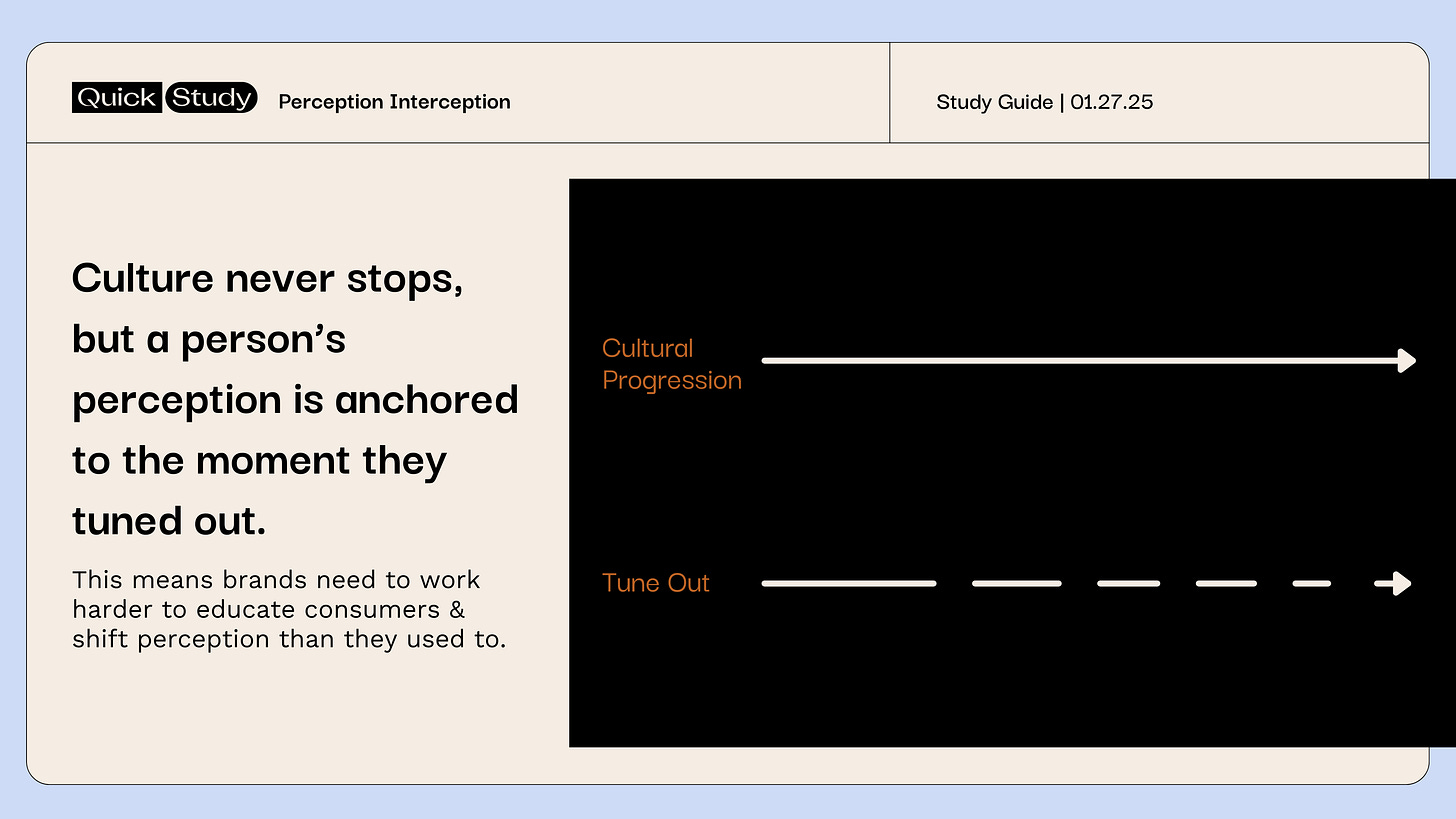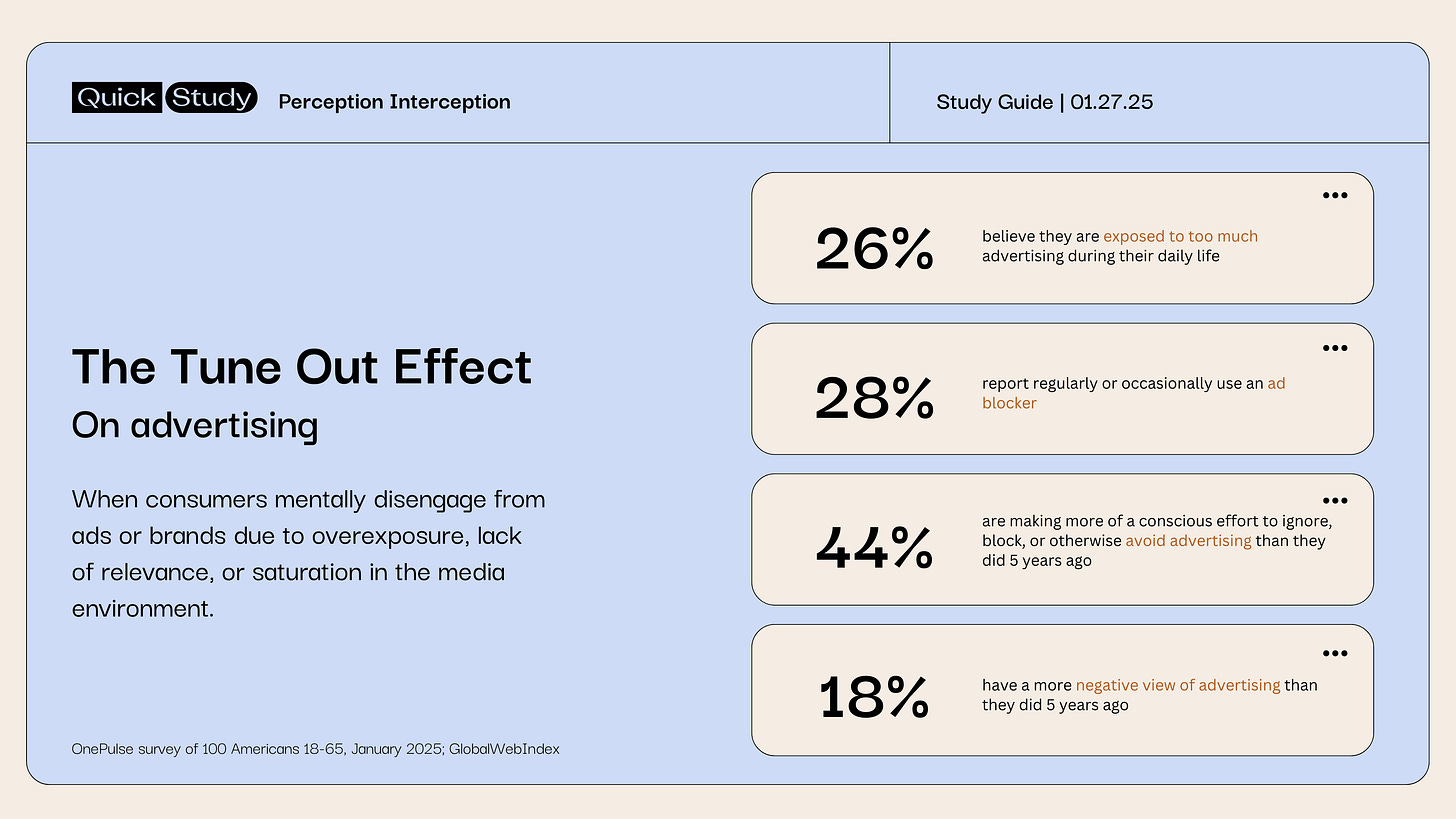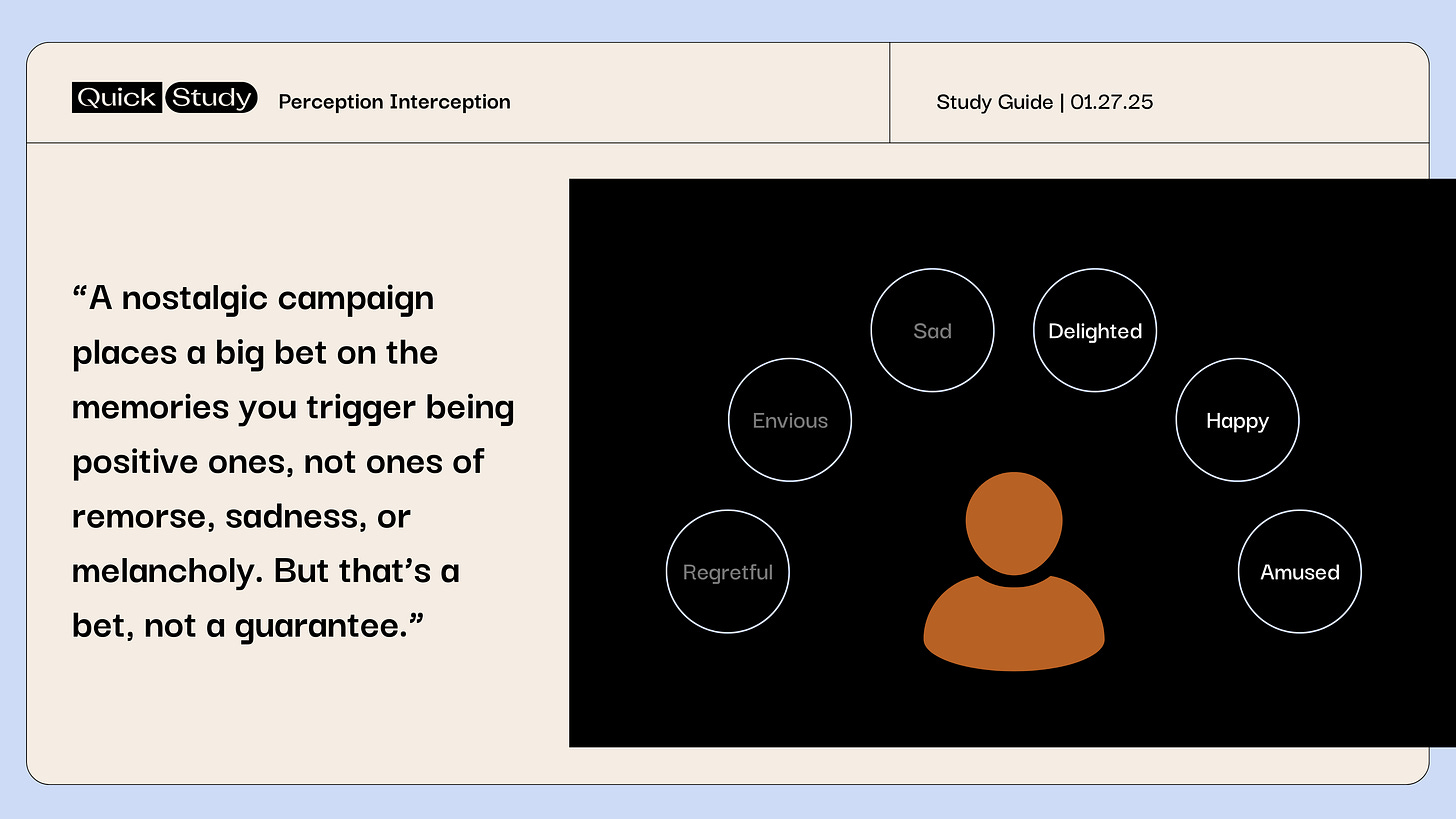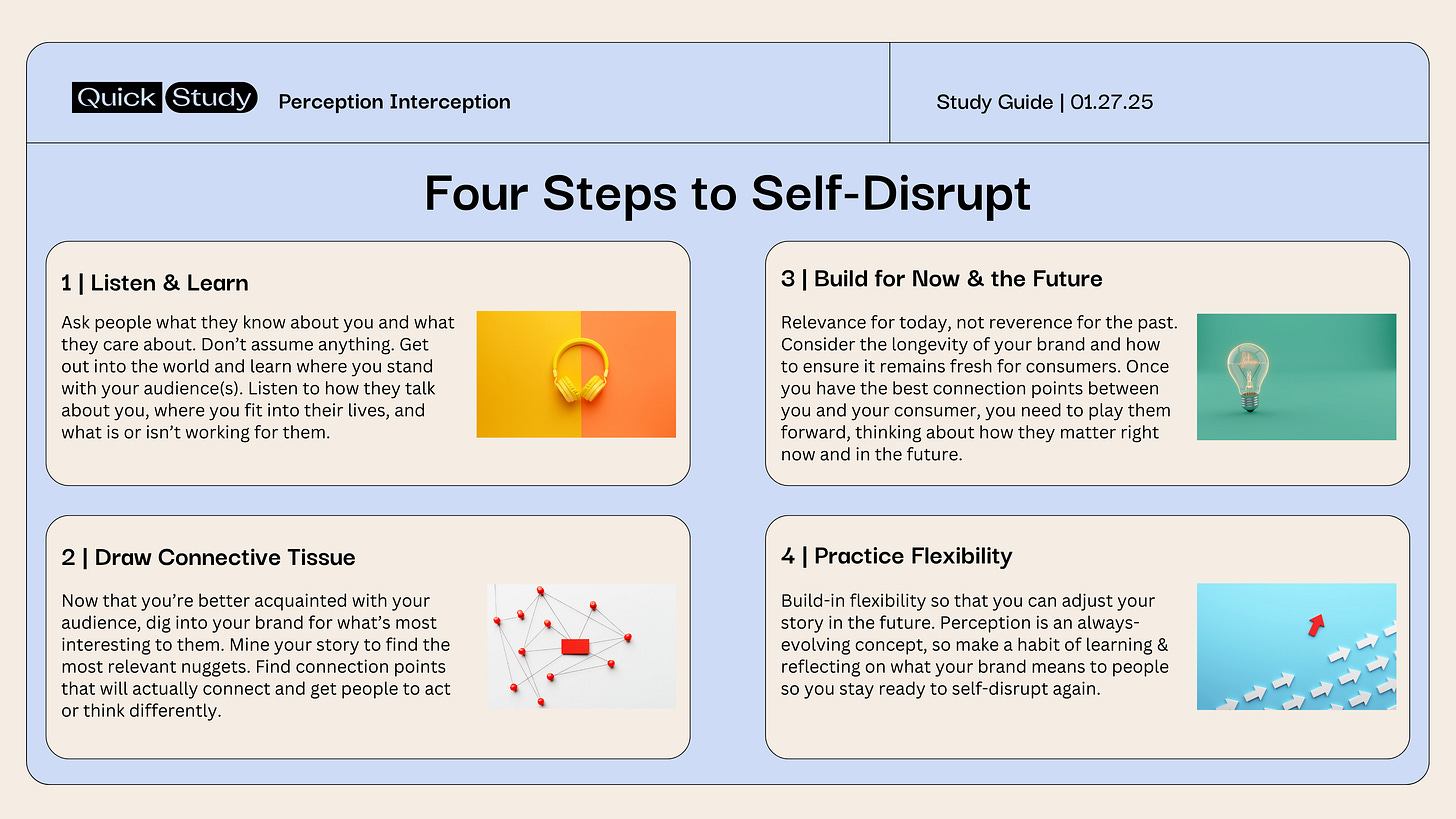Perception Interception
Self-disruption is the best way to get consumers to rethink your brand. Here’s how to do it.
Hey. Hi. Hello. This is The Other 90, a blog about strategy from your friends at Quick Study. Today’s newsletter takes about 9 minutes to read. You can also read this Study Guide on our website.
We’re off to a fast start in 2025 and excited for some new work to become public in the coming weeks and months. If your brand could benefit from a more impactful positioning, let’s chat: hello@quick.study
Let’s start here:
In the early 1950s, Malcom McLean had what was later described as a “managerial insight.” A trucking entrepreneur with a rapidly growing empire, McLean realized that “transport companies’ true business was moving freight rather than operating ships or trains.” This mental shift in how to perceive his industry enabled McLean to think outside, or in his case, inside the box… literally. Today, McLean is remembered as the man who brought container shipping to the world.
Turning this “insight” into a real shift didn’t happen overnight. At the time, many leading shipping companies held well-entrenched opinions about how to most effectively & efficiently ply their trade, and most were reluctant to be as self-disruptive as McLean was willing to be. Stuck in their biases and unwilling to reassess their operations, many companies and traditional ports of call disappeared in the mid-to-late 20th century, swallowed by their own hubris.
The combined forces McLean was up against that led him to his insight were what we at Quick Study call a relevance gap. McLean (and, to be fair, many other people in the 1940s & 50s as documented in Marc Levinson's excellent book The Box) saw that increased competition and inefficient processes were hurting his product and also the perception of what his product could mean for global trade & commerce. He attacked the gap created by those forces by embracing radical self-disruption, placing bets on what he could control, and working hard to shift how people viewed his venture.
While shifting all of global trade is not the scope most companies are working at, there is no brand or industry that is immune from relevance gaps, and there is no shortage of them to be dealt with. Relevance at any given time is finite; there is a set amount of relevance to go around that everyone is always fighting for. Much like the first law of thermodynamics – energy cannot be created nor destroyed, only transformed or transferred – things can come in and out of relevance, stay relevant, or never achieve relevance, but there is never more relevance in general to be given. That is the biggest hurdle any brand faces today, and it’s why Quick Study has built its process to focus on these gaps – what they are, how they shift over time, and the best ways to close them.
In the past…
We’ve discussed schisms caused by fragmentation, the speed of cultural change, and the lack of connection humans currently feel toward each other and brands. These gaps all widened over the course of 2024, and it’s depressing but accurate to predict that they will continue to worsen in 2025 given the current cultural climate. But those friction points, as important as they are, are generally out of the hands of brands and dependent on broader cultural movement. In other words, they are not issues that can be solved solely by a brand’s actions.
There is, however, another bucket of relevance gaps that are less dependent on other cultural forces. These are of a brand’s own making, which means they can also be addressed when the brand so chooses. One of them is brand perception, specifically the dated perceptions that many brands carry like a dark cloud over their marketing work.
In 2025, addressing the consumer perception of your brand is more critical than ever because external challenges beyond your control are escalating quickly. Perception is a gateway to relevance that is shaped and shifted over time, but doing so requires thoughtful consideration and a lot of follow-through. Today we’ll dig into how brands can approach fixing their perception, and why adopting a habit of self-disruption is key to staying ahead of the curve.
When was the last time you honestly asked your audience what they thought of you?
A lot of brands have their versions of “health trackers” or “dashboards”, but are they as insightful as they could/should be? If it’s been a while since you truly did talk to your audience, you’re not alone. It’s easy to become engrossed in the internal perspectives and narratives of a brand and forget that you are speaking to actual people in the real world who have different experiences and thoughts than the team working on the brand does (not to mention much less exposure to the marketing being created!).
On top of that, cultural time has sped up since the pandemic in ways many brands have not adjusted for. Our research last year found that 59% of Americans feel like time is moving faster than ever before. Instead of reacting to this and adjusting how they tell their story, many brands seem intent on cosplaying as Jack Donaghy from 30 Rock, using outdated strategies instead of accepting the new consumer landscape. A generic funnel-based strategy that uses the same content on social media, digital, and TV was novel in the early 2010s, but not anymore, despite the willingness of so many to continue dipping into the same old well.
Brand decisions are made by people, and the reason that many brands aren’t acting like times have changed is because people have tuned out. The onslaught of content, politics, everything since the late 2010s has caused a lot of folks to stop listening, their opinions cemented in time but carried forward forever. A survey by Quick Study of 100 Americans aged 18-65 found that 28% are making more of a conscious effort to “tune out” culture than they did 5 years ago and 25% plan on tuning out more often moving forward. This level of “tune out” is massive, and it shifts the relationship between consumers and brands because consumers are no longer engaged with your story at the depth they were before. It's a modified version of the anchor bias, but the anchor this time isn't the first thing someone learned about you, it's the last thing someone paid attention to about you.
One area we see this tune out occurring is social media. Since Q2 2020, both the amount of Americans who say they are using social media less and the amount who say they are trying to limit their on social have gone up (stats via GlobalWebIndex). One thing that’s gone down in the last 5 years: Americans who think social media is good for society.
Given the current political climate, it's unsurprising that the tune out has hit news as well. News networks that saw a massive spike in viewership during President Trump’s first term aren’t seeing signs of the same spike this time around. An Associated Press-NORC Center for Public Affairs Research survey in December found that “about two-thirds of American adults say they have recently felt the need to limit media consumption about politics and government because of overload.”
Most importantly for our conversation today, the Great Tune Out™ is a direct hit to advertisers. 26% of Americans believe they are exposed to too much advertising during their daily life, and 28% say they regularly or occasionally use an ad blocker. We found that 44% of Americans are making more of a conscious effort to ignore, block, or otherwise avoid advertising than they did 5 years ago, and 18% have a more negative view of advertising than they did in 2020.
This cultural shift should impact not only the platforms and channels where marketing dollars are being spent, but the marketing itself, too. And yet, it’s obvious that most brands are not adjusting to this mass tune out in a meaningful way. Many brands continue to act with the expectation that their consumer is curious, but the reality is that consumers are too busy or overloaded to be curious about everything. As we discussed in our Study Guide about the failure of brand-owned communities, the assumption that consumers will come to you because you ask is outdated and misplaced. There are so few examples of this tactic working, yet time and time again we see brands build campaigns that consumers have to jump through hoops to participate in, consume, or otherwise engage in. Using these types of tactics only confirms existing perceptions, because it’s one thing to get people to pay attention to you, but it’s a whole 'nother thing to get people to change their mind.
When brands do correctly ID existing perception gaps, they typically address them in one of three ways:
Waiting for the trend cycle to come back to meet the brand where they are
Waiting out a trend cycle is easier in certain categories like fashion. The resurgence over the last few years of “mall brands” like Gap and J. Crew reflect the cyclical nature of fashion as they continue to lean into their “greatest hits” - efforts that didn’t work a few years ago but work now that the cycle has come back their way (like the virality of Gap’s dancing ads in 2024). And while we know timing is everything, “let’s wait” is not something shareholders like to hear, especially when trend cycles are more unpredictable and short-lived.
Using nostalgia to create a permission structure for the outdated perception
Nostalgia is a tricky emotion to hang a brand’s hat on. For one, it’s become a seriously over-used tactic in the storytelling space. Second, while nostalgia provides emotional comfort for some, that response is not universal. When working with the iconic Crush soda in 2023, we wanted to better understand how nostalgia works. We found compelling research that positioned nostalgia less as its own emotion and more as a bridge between other emotions like love, sadness, and happiness. We also asked consumers to rank the emotions they most associate with nostalgia. Results indicated that using nostalgia as a blanket tactic gives you little control over which memories or feelings your work might evoke. A nostalgic campaign places a big bet on the memories you trigger being positive ones, not ones of remorse, sadness, or melancholy. But that’s a bet, not a guarantee.
Treating a perception issue by waiting it out or relying on nostalgia leaves control with others. In 2025, that is a risky bet, so instead, it’s time to bet on yourself and your ability to shift the narrative. Which leaves us with…
Practicing self-disruption by shaking up the story they're telling.
Yes, shifting perception takes some work. But if you reposition your brand in the present day, the rewards will be long-term. This isn’t about creating a completely new version of your brand that is palatable today; it’s about finding a part of your brand’s foundation that honestly links with the culture of your consumer. Self-disruption - choosing where you can innovate, push boundaries, be bold, etc. - is the name of the game here. It should feel empowering to get under the hood and ask honest, fresh questions about what you bring to the table and what your audience might be excited by. If you are unable or unwilling to take an honest look at where you could be more disruptive with your own story, you’ll default to waiting on others to change your story for you, or fall behind others who are better at keeping their perception strong.
There are myriad ways you can approach self-disruption in order to shift consumer perception, but here is a quick four-step process to work against:
Listen & Learn. First things first, you need to ask people what they know about you and what they care about. Don’t assume anything. Get out into the world and find out exactly where you stand with your audience(s). Listen to how they talk about you, where you fit into their lives, and what is or isn’t working for them right now. Let the most interesting findings bubble to the top.
Draw Connective Tissue. Next, mine your story to find the most relevant nuggets. Now that you’re better acquainted with where your consumer is today, dig into your own brand to find what will be most interesting to them. Maybe this is a product conversation, a heritage conversation, or something else. Regardless, you need to find connection points that will actually connect (i.e. excite, intrigue, get people to act and/or think differently, etc.).
Build for Now & the Future. Relevance for today, not reverence for the past. It’s easy to find part of a brand’s legacy and simply try to remind people that it exists. This is not the right answer. Instead, think about the longevity of your brand and how to ensure it remains fresh for consumers. Once you ID the best possible connection points between you and your consumer, you need to play them forward, thinking about how they matter right now and in the future.
Practice Flexibility. Create flexibility so you can continue to adjust your story in the future. Perception is an always-evolving concept, and you cannot do this process once and then walk away. Build a habit of learning & reflecting on what your brand means to people so that you can always be ready to self-disrupt again as needed.
Fixing your perception goes a long way to setting your brand up for a relevant future, but it’s only one part of a much larger puzzle. With so many relevance gaps widening headed into 2025, brand leaders need to keep their heads on a swivel, stay extra engaged in their storytelling, and be willing to put in the work now that will pay off down the line. If that sounds like a project you’re willing to take on in 2025, feel free to reach out to us at Quick Study. We look forward to closing the gap(s) with you by thinking outside (or maybe even inside) the box.
The Other 90 is written by Rob Engelsman, a former baby model and now Cofounder & Strategy Partner at Quick Study. To find out more about how we help brands and agencies get to smarter plans faster, email hello@quick.study. You can also find Quick Study on LinkedIn.

